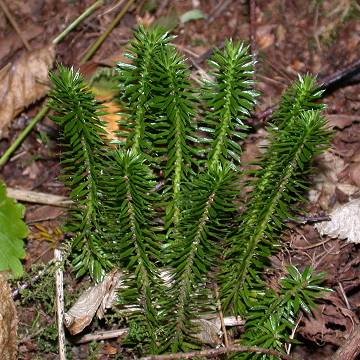

Huperzia lucidula - (image 1 of 3)
Taxonomy
Family: Lycopodiaceae
Habitat
Cool, moist woods, stream banks. Also swamp margins in organic, subacid soil or epipetric.
Associates
In young woods of Acer rubrum and Sassafras albidum it grows with Lycopodium clavatum and Lycopodium obscurum.
Distribution
Morphology
Low evergreen from horizontal stems, erect portions to 25cm high. Leaves irregular reflexed to spreading, elliptic-oblanceolate, shiny, to 1.5mm long and 2mm wide, sparsely tooth at the apex. Gemmae (vegetative buds) minute, flattened, apiculate-lobed, on small branch-like structure along the stems. Sporangia borne along the stems in pouch-like structures in the axils of leaves..
Notes
Produces spores from early June to early September.
Wetland indicator: FAC
This species differs from other club mosses in that the spores are not in terminal cones but borne along the stem. The gemmae can detach from the stem and form new plants.
References
Haines, A. 2011. Flora Novae Angliae: a manual for the identification of native and naturalized higher vascular plants of New England. Yale University Press, New Haven, CT.
Lellinger, D. B. and M. Evans. 1985. A Field Manual of the Ferns & Fern Allies
of the United States and Canada.
Smithsonian Institution Press. Washington, D.C.
Swink, F. and G. Wilhelm. 1994. Plants of the Chicago Region.
Indiana Academy of Science. The Morton Arboretum. Lisle, Illinois.
|
Michael Hough © 2005, 2018 |